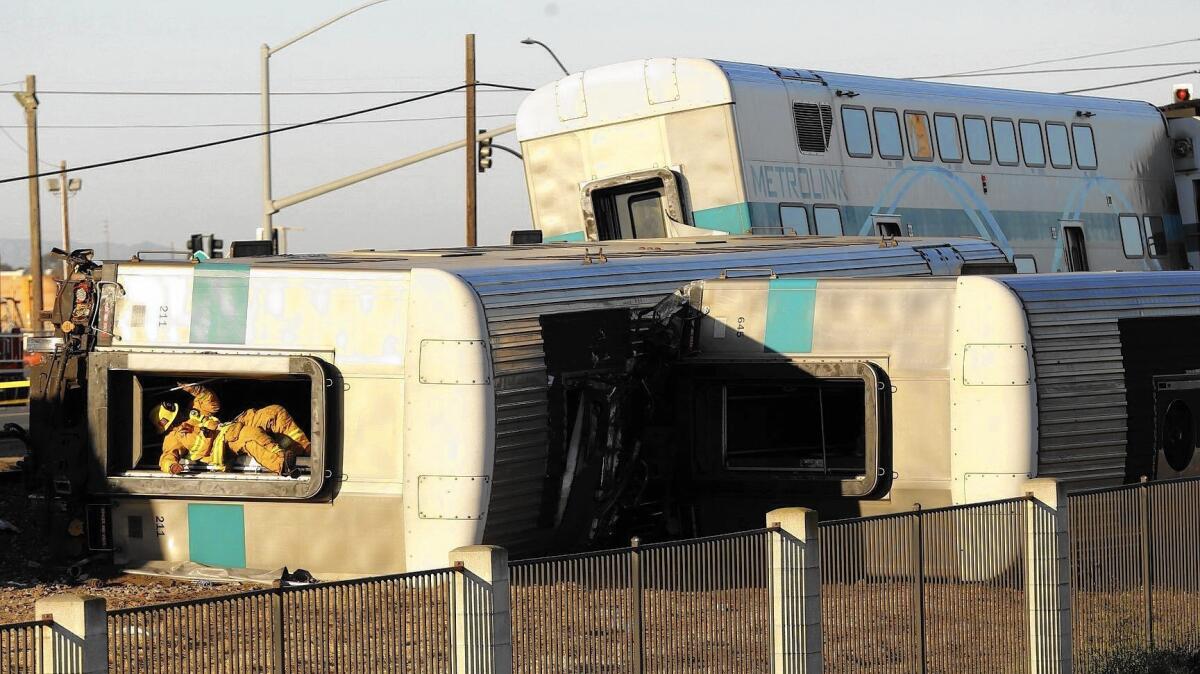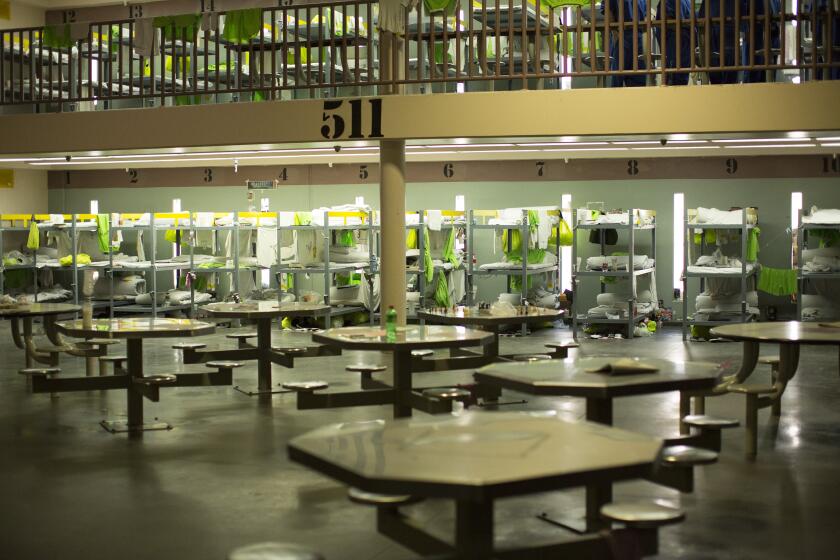Metrolink train cars that derailed in Oxnard had flawed parts, confidential report finds

Thirty-one passengers and two crew members were hurt, one fatally, in the crash of a Metrolink train and a pickup truck in Oxnard on Feb. 24.
- Share via
The new Metrolink passenger cars that derailed in a crash near Oxnard this year were equipped with flawed parts that were supposed to help keep trains on the track in an accident, according to a confidential report by the commuter railroad.
The report, however, does not make any conclusions about the role of the defects in the Feb. 24 accident — an aspect of the crash that is now under federal investigation.
According to Metrolink, two couplers on passenger cars and the cow-catcher of a cab car at the front of the train broke in the collision with a heavy-duty pickup truck and trailer that strayed onto the tracks at a grade crossing. Thirty-one passengers and two crew members were hurt. The engineer, Glenn Steele, later died of his injuries.
Cow-catchers are plow-like devices that can deflect objects on the tracks and prevent debris or wreckage from getting under the wheels of trains. Couplers can help prevent derailments by keeping rail cars aligned and upright during a crash.

A confidential Metrolink report says rail cars that derailed were equipped with faulty parts that were supposed to keep the cars on the tracks in a crash.
The report says the cow-catcher of the cab car -— a passenger coach with an engineer’s station -— did not meet design specifications for the amount of force it was supposed to withstand.
Presented by railroad officials to the Metrolink board at a closed meeting on Sept. 11, the report further states that the coupler failures caused several train cars to slam into each other and derail. According to Metrolink, one coupler showed signs of a manufacturing flaw that might have weakened it.
Whether the specification and manufacturing issues detailed in the report contributed to the derailment and severity of the collision is under investigation by the railroad and the National Transportation Safety Board. Those issues also might play a role in the complicated legal situation and mounting damage claims resulting from the crash.
The NTSB is responsible for exploring all aspects of the collision, determining the probable cause and making safety recommendations. No conclusions have been reached yet.
Art Leahy, Metrolink’s chief executive, declined to discuss the railroad’s internal report, citing its confidentiality. He added, however, that “the NTSB may come back and say there is no issue here. We are awaiting their findings.”
Andrew K. Hyer, a spokesman for the manufacturer, Hyundai Rotem Inc. of South Korea, said the NTSB has instructed all parties to refrain from speaking to the news media to protect the integrity of the investigation.
In general, Hyer said safety was Hyundai Rotem’s highest priority and that the company has no reason to believe that any of the cars were defective or had anything to do with the derailment.
“We take tremendous pride in our corporate culture and global reputation for delivering safe and reliable passenger rail equipment,” he said. “We are therefore committed to working cooperatively with Metrolink during the NTSB investigation.”
The confidential report, however, states that the manufacturer failed to meet design specifications that Metrolink required for cow-catchers on cab cars. The unmet specifications related to struts that extended into the car body and a requirement that cow-catchers be able to withstand a load of 100,000 pounds. The document noted that the specifications “may need to be more robust.”
In addition, the report stated that the cow-catcher had some poor welds and that other parts of the device “showed probable failure” despite extra brackets and good welding in other places. A photo attached to the report shows that the cow-catcher had broken off the cab car. Arrows point to four weld failures and areas where bolts were sheared off.
According to the report, a metallurgist found that one of the two failed couplers displayed evidence of a manufacturing defect known as porosity — a casting flaw that causes voids and bubbles to form in the metal.
It is unclear why the parts were not discovered before the rail cars were put into service. In general, rail experts say, both railroads and manufacturers of rolling stock have quality control measures to test and inspect new rail cars for potential defects.
Meanwhile, the couplers and cow-catcher in question could become part of a wave of lawsuits that might be filed by and against the railroad, including cases involving Hyundai Rotem and engineering companies that designed the cars.
According to the report, Metrolink officials have discussed the possibility of lawsuits on a variety of grounds involving alleged manufacturing flaws, the truck driver’s employers and the state and local agencies responsible for the upkeep and design of the grade crossing where the truck drove onto the tracks.
“We won’t accept anything defective. If there’s evidence of this, people will be held accountable,” said Orange County Supervisor Shawn Nelson, chairman of Metrolink’s board. “We won’t tolerate anyone who has failed us, and we won’t tolerate anyone who has failed the public.”
The report notes that at least 28 passengers and Steele’s family have lodged claims so far against Metrolink for damages, the first step toward filing a lawsuit. The railroad has directed those claimants to the Grower’s Co., where the truck driver worked as a mechanic, and to Harvest Management, the owner of the pickup truck and trailer.
The rail cars involved in the Oxnard crash are among 137 passenger coaches that Metrolink bought several years ago from Hyundai Rotem for $263.3 million. Of the total, 57 are cab cars, which are placed in the front for trains when they reverse direction. Hyundai delivered the last coaches to Metrolink in June 2013.
Dubbed the “Guardian Fleet” by the railroad, the Rotem car bodies have crumple zones that cushion the impact of crashes and other safety measures now required by the federal government, such as breakaway tables, more fire retardant materials and improved rescue access.
Metrolink officials have said the cars represent a milestone in their efforts to regain public trust after the 2005 Glendale crash killed 11 people and a horrific head-on collision with a Union Pacific freight train outside Chatsworth station in 2008 that left 25 dead and 135 injured.
In the aftermath of the Oxnard crash, railroad officials were quick to claim the cars had saved lives and reduced injuries because they were equipped with the latest safety improvements.
Today, however, Metrolink is reviewing its Rotem fleet and is in the process of temporarily replacing the cab cars with locomotives leased at a cost of $23.9 million from the Burlington Northern Santa Fe Railway Co.
Until the safety issues are resolved, the cab cars will be used as passenger coaches but placed farther back in the line-up of train cars. Leahy said the Burlington Northern engines were being tested and have not been put into service yet.
Follow @LADeadline16 for transportation and aviation news
ALSO
Alleged buyer of guns used in San Bernardino shooting may face several charges
City Council concerns spur delay on vote to buy LAPD body cameras
Video shows suspected gunman at Standard hotel in downtown L.A., police say
More to Read
Sign up for Essential California
The most important California stories and recommendations in your inbox every morning.
You may occasionally receive promotional content from the Los Angeles Times.











